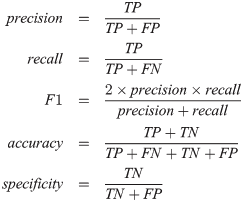Tensorflow Précision / Rappel / F1 score et la Confusion de la matrice
from sklearn.metrics import confusion_matrix
confusion_matrix(y_true, y_pred)
dans un modèle tensorflow pour obtenir le score différent.
with tf.Session(config=tf.ConfigProto(log_device_placement=True)) as sess:
init = tf.initialize_all_variables()
sess.run(init)
for epoch in xrange(1):
avg_cost = 0.
total_batch = len(train_arrays) / batch_size
for batch in range(total_batch):
train_step.run(feed_dict = {x: train_arrays, y: train_labels})
avg_cost += sess.run(cost, feed_dict={x: train_arrays, y: train_labels})/total_batch
if epoch % display_step == 0:
print "Epoch:", '%04d' % (epoch+1), "cost=", "{:.9f}".format(avg_cost)
print "Optimization Finished!"
correct_prediction = tf.equal(tf.argmax(pred, 1), tf.argmax(y, 1))
# Calculate accuracy
accuracy = tf.reduce_mean(tf.cast(correct_prediction, "float"))
print "Accuracy:", batch, accuracy.eval({x: test_arrays, y: test_labels})
5 réponses
vous n'avez pas vraiment besoin de sklearn pour calculer précision/rappel/score f1. Vous pouvez facilement les exprimer de façon TF-ish en regardant les formules
Maintenant, si vous avez votre actual et predicted valeurs comme vecteurs de 0/1, vous pouvez calculer TP, TN, FP, FN en utilisant tf.count_nonzero:
TP = tf.count_nonzero(predicted * actual)
TN = tf.count_nonzero((predicted - 1) * (actual - 1))
FP = tf.count_nonzero(predicted * (actual - 1))
FN = tf.count_nonzero((predicted - 1) * actual)
maintenant, vos mesures sont faciles à cacluler:
precision = TP / (TP + FP)
recall = TP / (TP + FN)
f1 = 2 * precision * recall / (precision + recall)
peut-être que cet exemple vous parlera :
pred = multilayer_perceptron(x, weights, biases)
correct_prediction = tf.equal(tf.argmax(pred, 1), tf.argmax(y, 1))
accuracy = tf.reduce_mean(tf.cast(correct_prediction, "float"))
with tf.Session() as sess:
init = tf.initialize_all_variables()
sess.run(init)
for epoch in xrange(150):
for i in xrange(total_batch):
train_step.run(feed_dict = {x: train_arrays, y: train_labels})
avg_cost += sess.run(cost, feed_dict={x: train_arrays, y: train_labels})/total_batch
if epoch % display_step == 0:
print "Epoch:", '%04d' % (epoch+1), "cost=", "{:.9f}".format(avg_cost)
#metrics
y_p = tf.argmax(pred, 1)
val_accuracy, y_pred = sess.run([accuracy, y_p], feed_dict={x:test_arrays, y:test_label})
print "validation accuracy:", val_accuracy
y_true = np.argmax(test_label,1)
print "Precision", sk.metrics.precision_score(y_true, y_pred)
print "Recall", sk.metrics.recall_score(y_true, y_pred)
print "f1_score", sk.metrics.f1_score(y_true, y_pred)
print "confusion_matrix"
print sk.metrics.confusion_matrix(y_true, y_pred)
fpr, tpr, tresholds = sk.metrics.roc_curve(y_true, y_pred)
depuis que je n'ai pas assez de réputation pour ajouter un commentaire à Salvador Dalis réponse c'est la voie à suivre:
tf.count_nonzero jette vos valeurs dans un tf.int64 sauf indication contraire. En utilisant:
argmax_prediction = tf.argmax(prediction, 1)
argmax_y = tf.argmax(y, 1)
TP = tf.count_nonzero(argmax_prediction * argmax_y, dtype=tf.float32)
TN = tf.count_nonzero((argmax_prediction - 1) * (argmax_y - 1), dtype=tf.float32)
FP = tf.count_nonzero(argmax_prediction * (argmax_y - 1), dtype=tf.float32)
FN = tf.count_nonzero((argmax_prediction - 1) * argmax_y, dtype=tf.float32)
est une très bonne idée.
Utilisez les paramètres IPA fournis dans tf.contrib.les métriques, par exemple:
labels = ...
predictions = ...
accuracy, update_op_acc = tf.contrib.metrics.streaming_accuracy(labels, predictions)
error, update_op_error = tf.contrib.metrics.streaming_mean_absolute_error(labels, predictions)
sess.run(tf.local_variables_initializer())
for batch in range(num_batches):
sess.run([update_op_acc, update_op_error])
accuracy, mean_absolute_error = sess.run([accuracy, mean_absolute_error])
Multi-étiquette
les réponses précédentes ne spécifient pas comment gérer le cas multi-label alors voici une telle version implémentant trois types de multi-étiquette f1 score en tensorflow: micro, macro et pondéré (comme par scikit-learn)
mise à Jour (06/06/18): j'ai écrit un blog sur la façon de calculer le score de F1 en streaming multicabel dans le cas où il aide quelqu'un (c'est un processus plus long, ne veulent pas surcharger cette réponse)
f1s = [0, 0, 0]
y_true = tf.cast(y_true, tf.float64)
y_pred = tf.cast(y_pred, tf.float64)
for i, axis in enumerate([None, 0]):
TP = tf.count_nonzero(y_pred * y_true, axis=axis)
FP = tf.count_nonzero(y_pred * (y_true - 1), axis=axis)
FN = tf.count_nonzero((y_pred - 1) * y_true, axis=axis)
precision = TP / (TP + FP)
recall = TP / (TP + FN)
f1 = 2 * precision * recall / (precision + recall)
f1s[i] = tf.reduce_mean(f1)
weights = tf.reduce_sum(y_true, axis=0)
weights /= tf.reduce_sum(weights)
f1s[2] = tf.reduce_sum(f1 * weights)
micro, macro, weighted = f1s
rectitude
def tf_f1_score(y_true, y_pred):
"""Computes 3 different f1 scores, micro macro
weighted.
micro: f1 score accross the classes, as 1
macro: mean of f1 scores per class
weighted: weighted average of f1 scores per class,
weighted from the support of each class
Args:
y_true (Tensor): labels, with shape (batch, num_classes)
y_pred (Tensor): model's predictions, same shape as y_true
Returns:
tuple(Tensor): (micro, macro, weighted)
tuple of the computed f1 scores
"""
f1s = [0, 0, 0]
y_true = tf.cast(y_true, tf.float64)
y_pred = tf.cast(y_pred, tf.float64)
for i, axis in enumerate([None, 0]):
TP = tf.count_nonzero(y_pred * y_true, axis=axis)
FP = tf.count_nonzero(y_pred * (y_true - 1), axis=axis)
FN = tf.count_nonzero((y_pred - 1) * y_true, axis=axis)
precision = TP / (TP + FP)
recall = TP / (TP + FN)
f1 = 2 * precision * recall / (precision + recall)
f1s[i] = tf.reduce_mean(f1)
weights = tf.reduce_sum(y_true, axis=0)
weights /= tf.reduce_sum(weights)
f1s[2] = tf.reduce_sum(f1 * weights)
micro, macro, weighted = f1s
return micro, macro, weighted
def compare(nb, dims):
labels = (np.random.randn(nb, dims) > 0.5).astype(int)
predictions = (np.random.randn(nb, dims) > 0.5).astype(int)
stime = time()
mic = f1_score(labels, predictions, average='micro')
mac = f1_score(labels, predictions, average='macro')
wei = f1_score(labels, predictions, average='weighted')
print('sklearn in {:.4f}:\n micro: {:.8f}\n macro: {:.8f}\n weighted: {:.8f}'.format(
time() - stime, mic, mac, wei
))
gtime = time()
tf.reset_default_graph()
y_true = tf.Variable(labels)
y_pred = tf.Variable(predictions)
micro, macro, weighted = tf_f1_score(y_true, y_pred)
with tf.Session() as sess:
tf.global_variables_initializer().run(session=sess)
stime = time()
mic, mac, wei = sess.run([micro, macro, weighted])
print('tensorflow in {:.4f} ({:.4f} with graph time):\n micro: {:.8f}\n macro: {:.8f}\n weighted: {:.8f}'.format(
time() - stime, time()-gtime, mic, mac, wei
))
compare(10 ** 6, 10)
sorties:
>> rows: 10^6 dimensions: 10
sklearn in 2.3939:
micro: 0.30890287
macro: 0.30890275
weighted: 0.30890279
tensorflow in 0.2465 (3.3246 with graph time):
micro: 0.30890287
macro: 0.30890275
weighted: 0.30890279
